Yoga offers many benefits: from reduced stress to improved strength and flexibility - but it can also be intimidating to many people. You might feel that you just "don't bend that way" or might not be able to keep up with others in a class, or have physical limitations that prevent you from easily moving up from and down to the floor or standing for an hour (or two!). Enter chair yoga, a gentle style of yoga you can do from a (mostly) seated position that also incorporates the breathing and mind-body benefits of a traditional class.
Whether you're in a confined space, such as a cubicle or an airplane seat, you have mobility issues, or you're just looking for a few stretches you can do that simply feel good and help you melt away tension, this series of seated yoga exercises can be a great addition to your daily routine.
These poses are suitable for most people, including seniors, people living with chronic pain, and those who use a wheelchair. Any contraindications are included with the poses.
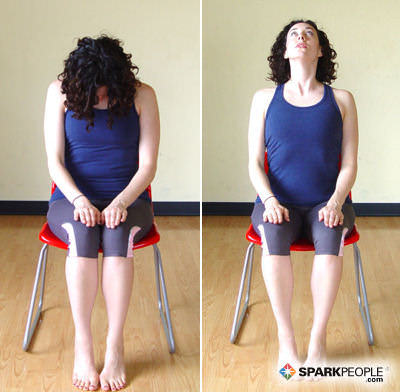 1. Seated Neck Rolls
1. Seated Neck Rolls Benefits: This warm-up pose releases tension from the neck, which is particularly important if you spend a lot of time sitting. Avoid this pose if you have any issues or injuries to the neck or cervical spine.
Begin by sitting up straight in a chair. Gaze up to the ceiling, keeping your neck long. Then bring your left ear down towards your left shoulder and hold (not pictured). Roll your head down toward the ground and bring your chin to your chest. Hold and finally, roll your head to the right and bring that ear to your right shoulder (not pictured). Inhale and exhale through the nose in a slow and controlled manner. Repeat twice.
For a deeper stretch, extend the right arm down toward the ground and hold while your left ear is toward your left shoulder (and vice versa). You should be relaxing your neck muscles and using the weight of your head to stretch. Do not attempt to force your head lower with your neck muscles or your hands. Stop immediately if you feel any discomfort.
Repeat five times on each side, taking long, slow and even breaths through the nose.
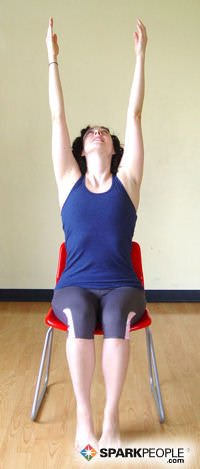 2. Seated Mountain Pose
2. Seated Mountain PoseBenefits: Mountain pose is sometimes called "samasthiti" or equal standing. This pose is often practiced at the beginning of a class and between poses as a way to reset and balance the body. The seated variation allows you to check in with your posture, release tension from the upper body, and focus on the breath while engaging the core.
Begin by sitting up straight in a chair. Roll your shoulder blades back and down, arms relaxed at your sides. Pull your bellybutton in to your spine to engage your abs, and keep your feet flat on the floor, if possible. Inhale through the nose and raise your arms overhead. Keep your arms shoulder width apart, and relax your shoulders. If you feel your shoulders creep up around your ears, relax them. Keep the belly strong, and gaze in between your hands, to the ceiling.
Stay here for five breaths.
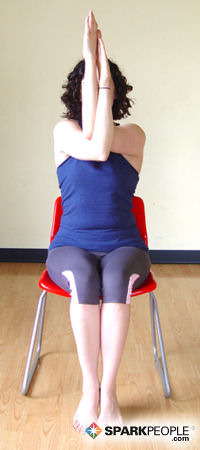 3. Seated Eagle Arms
3. Seated Eagle Arms Benefits: This arm and shoulder stretch targets the wrists and the space in between the shoulder blades, which is a difficult area to stretch.
Begin by sitting up straight in a chair. Roll your shoulder blades back and down, arms relaxed at your sides. Pull your bellybutton in to your spine to engage your abs, and keep your feet flat on the floor, if possible. Extend your arms out in front of you at 90-degree angles, palms facing each other (not pictured). Then place your right arm under your left and press the backs of your palms together. (If your arms and shoulders are tight, you might not to get your arms as close as pictured. That's OK. You'll still feel this stretch.)
Inhale and sit tall, then exhale and tuck your chin to your chest to stretch the back of the neck. Hold the pose for five breaths, then switch arms and stay another five breaths.
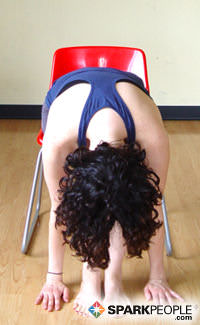 4. Seated Forward Fold
4. Seated Forward Fold Benefits: Seated forward fold lowers your head below the heart, which can have a calming effect. This pose is designed to reduce stress and stretch the spine and hamstrings. Avoid this pose if you have high blood pressure or eye issues, such as glaucoma or detached retinas.
Begin by sitting up straight in a chair. Roll your shoulder blades back and down, arms relaxed at your sides. Pull your bellybutton in toward your spine to engage your abs, and keep your feet flat on the floor, if possible. Spread your legs slightly wider than hip's distance apart. Exhale and hinge from the hip, slowly lowering your hands to the floor (or in contact with your thighs or shins). Then slowly round your upper back, lowering your chest in between your legs and relaxing your head and neck down. Allow your shoulders to relax and round.
Stay here for five breaths. Inhale and slowly roll up, allowing your head to be the last part of your body to lift. Relax the shoulders back and down.
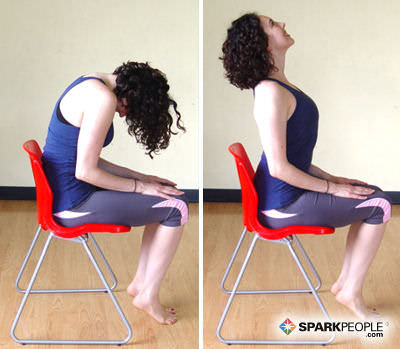 5 & 6. Seated Cat/Cow
5 & 6. Seated Cat/CowBenefits: This complementary pair of poses stretches the entire spine and improves spinal mobility. By arching the back in "cow" pose, you stretch the front torso and chest. In rounded-back "cat" pose, you help to stretch the back of the torso and shoulders. If you have any neck or cervical spine issues, keep the neck in line with the torso throughout these poses.
Begin by sitting up straight in a chair. Roll your shoulder blades back and down, arms relaxed at your sides. Pull your bellybutton in to your spine to engage your abs, and keep your feet flat on the floor, if possible. As you inhale, arch your back (leading with the chest) and look up toward the ceiling. Lift the chin and allow your arms to relax next to you. As you exhale, round your spine and let your head drop forward. Tuck the chin and allow your shoulders to roll.
Repeat five times, moving fluidly from cat to cow with each breath.
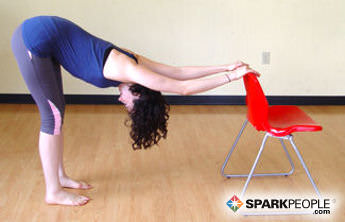 7. Standing Forward Fold with a Chair
7. Standing Forward Fold with a ChairBenefits: As with the seated variation, this forward fold modification offers a chance to let the head come below the heart, which can have a calming effect. This pose is designed to reduce stress, stretch the spine, and assist digestion. Avoid this pose if you have high blood pressure or eye issues, such as glaucoma or detached retinas.
Begin by standing about an arm's length away from a chair. Your feet should be directly under your hips; your shoulders should be back and down, with your abs engaged. Inhale and reach for the chair, allowing your body to roll down. Bend your knees slightly to prevent locking them, and allow the head to hang.
Stay for five breaths, and then roll up slowly.
 8. Seated Forward Bend with Chair
8. Seated Forward Bend with Chair Benefits: This pose allows the spine and hamstrings to stretch gently.
Sit on the floor in front of your chair with your legs extended in front of you, under the chair. Keep the chair set close enough to your body that you can touch it with your hands when the arms are outstretched. Pull your belly in to your spine to engage your abs and flex your feet to engage your legs. (Bend your knees if necessary if you cannot straighten them.) Hinge from the hip to place your hands/forearms onto the chair, and then allow your chin to drop toward your chest and your upper back to round slightly forward.
Stay here for five to 10 breaths, then slow roll your chin and chest up.
~Thank you Stepfanie Romine
No comments:
Post a Comment